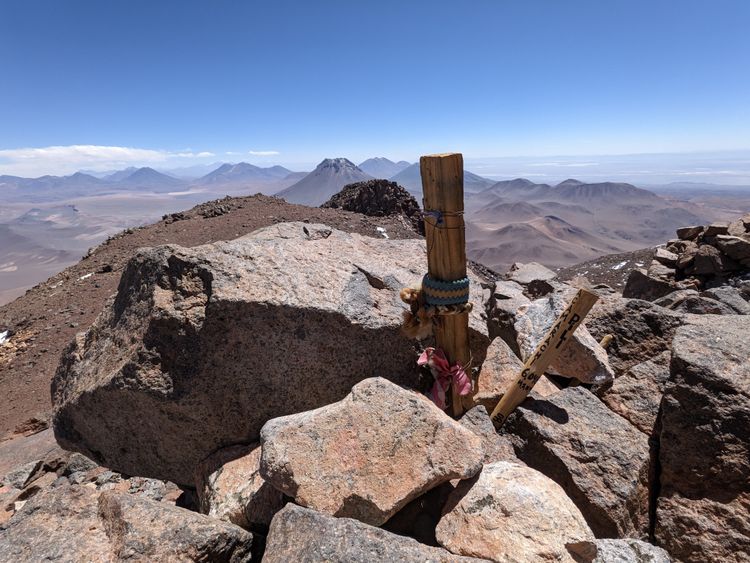Scaling Mount Llullaillaco: Adventure, and mountaineering in the Chilean Andes
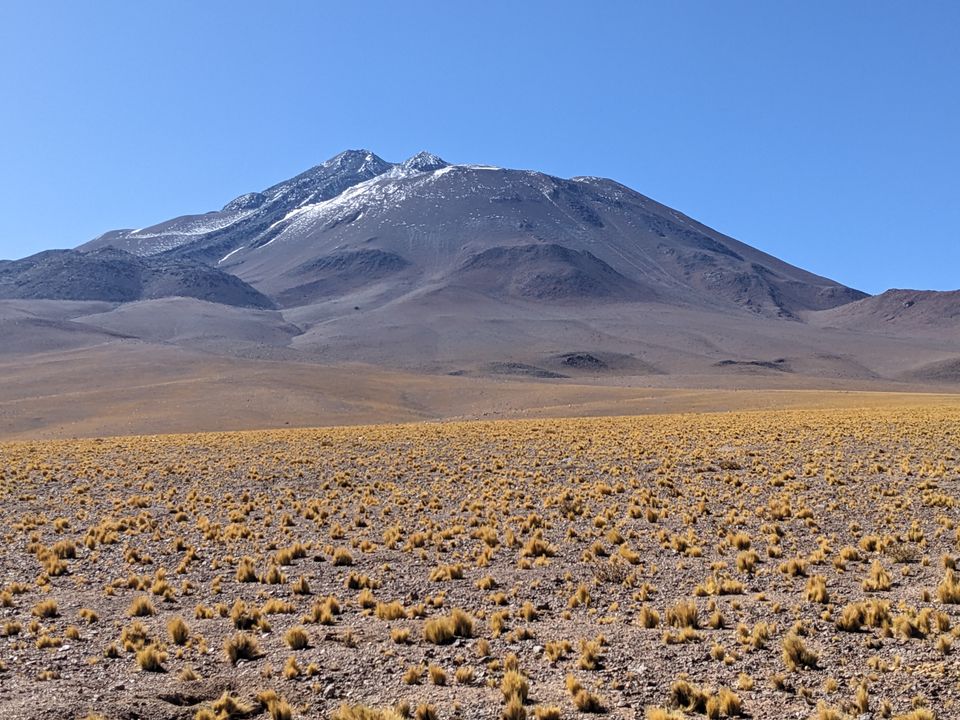
Mount Llullaillaco stands as a monument to both the marvels of nature and the echoes of history. Situated on the Chile-Argentina boundary, this mountain commands respect with its formidable height of 6,739 meters. It is located in a remote area of the Atacama desert, the Puna de Atacama. It also cradles secrets from a bygone era—the poignant discovery of three young Inca mummies is a testament to ancient rituals and gives a profound insight into Inca customs and beliefs.
Its geological makeup is equally riveting. As one of the highest volcanoes on our planet, Llullaillaco exhibits an intriguing interplay of solid lava strata and timeworn volcanic ash. Climbers aspiring to conquer it must not only grapple with its physical challenges but also contend with the mountain's capricious weather—sharp cold, erratic winds, and sporadic snow showers are the norm here, demanding both respect and thorough preparation.
From Antofogasta through the Mina Escondida to Refugio Zorritas
Our journey kicked off on January 14th, 2023, from the vibrant city of Antofagasta. Susi, our trusty Suzuki Jeep, was loaded with every essential, primed to transport us towards our ambitious goal.
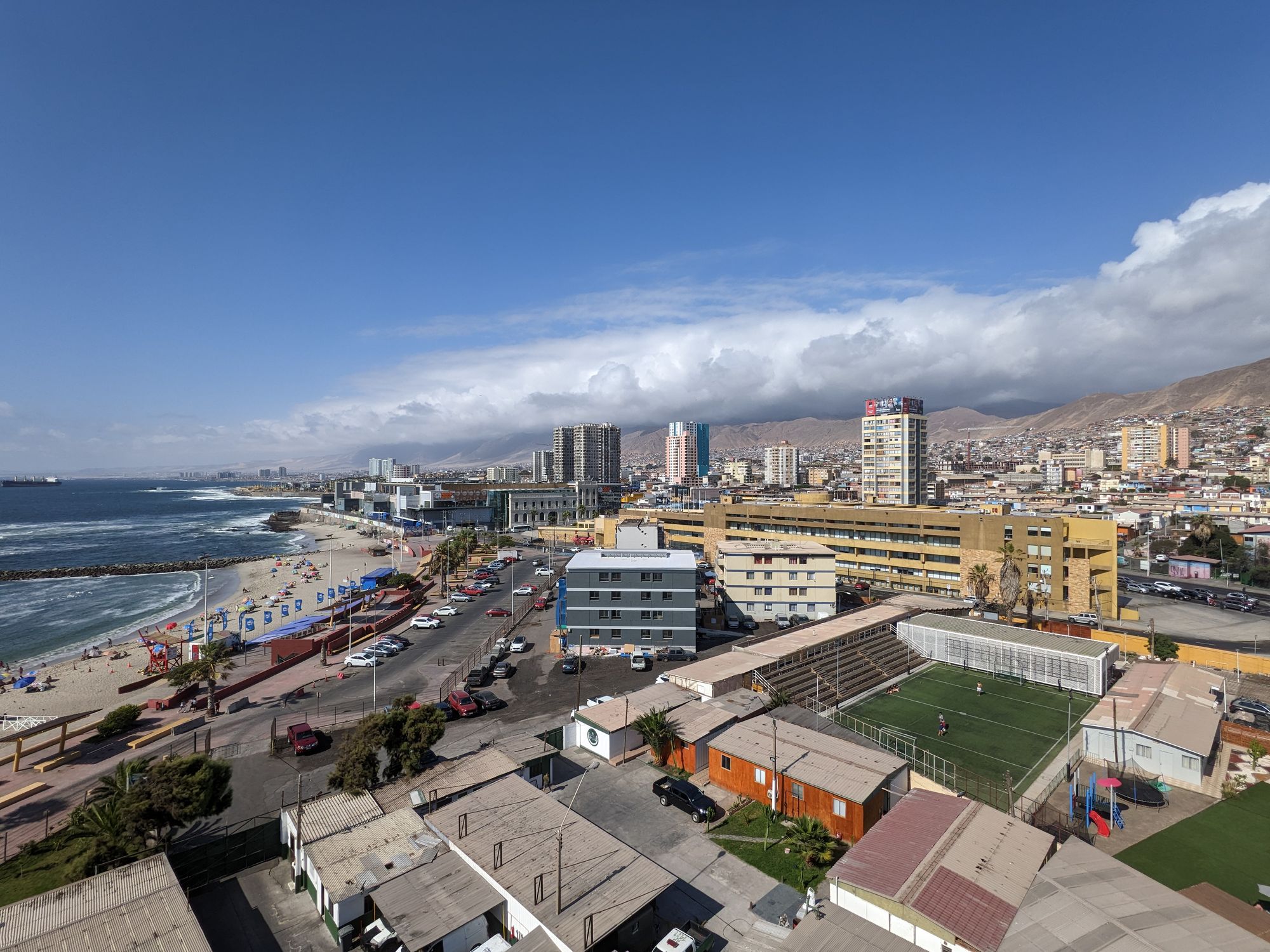
The first leg led us to La Negra's Copec tank station—the last fuel beacon before the embrace of the sprawling Andes engulfs travelers. With Susi replete and supplies double-checked, we headed deeper into the heart of the mountain range.
The B-475 unveiled the sprawling majesty of the Andes. Yet, the route soon took a rugged turn, ushering us into the expansive realm of Minas Escondida. Not just any mine, Minas Escondida is a titan in its own right—one of the world's premier sources of copper, reaffirming Chile's pivotal role in global copper trade. The sheer vastness of the mine complex initially felt disorienting. However, our journey was illuminated by the invaluable guidance of congenial local miners.
As we navigated deeper into Minas Escondida, the remnants of a burnt-out site loomed in our path. The stark contrast of the charred earth against the copper-rich terrain was disconcerting. Even more so, our route dictated that we skirt an area marked by a past explosion. The tales of minefields, some still haunting these terrains, were fresh in our minds, amplifying our trepidation. An agonizing half-hour followed, filled with palpable tension and apprehension. Yet, with collective determination and a dash of courage, we successfully traversed this intimidating stretch.
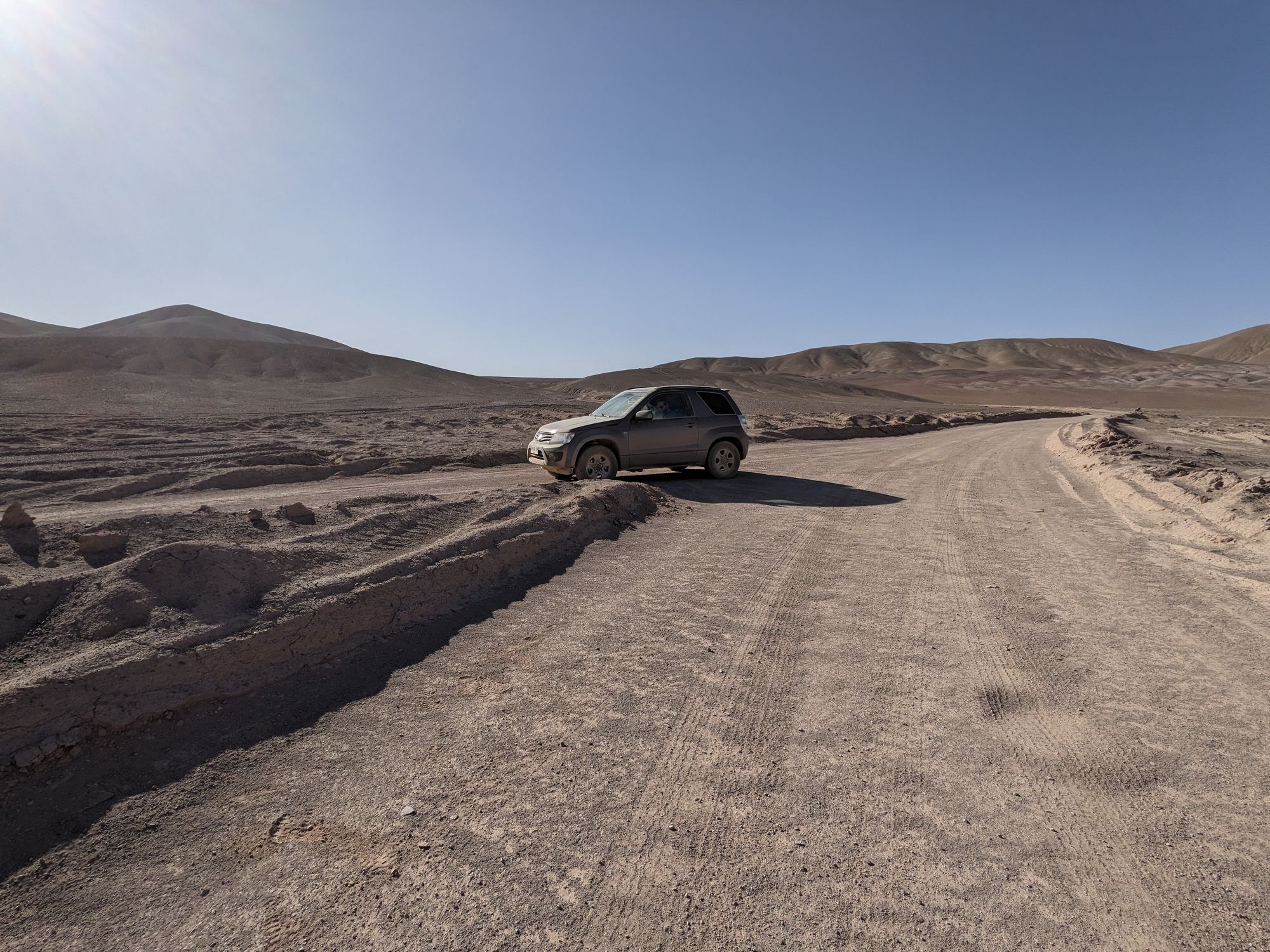
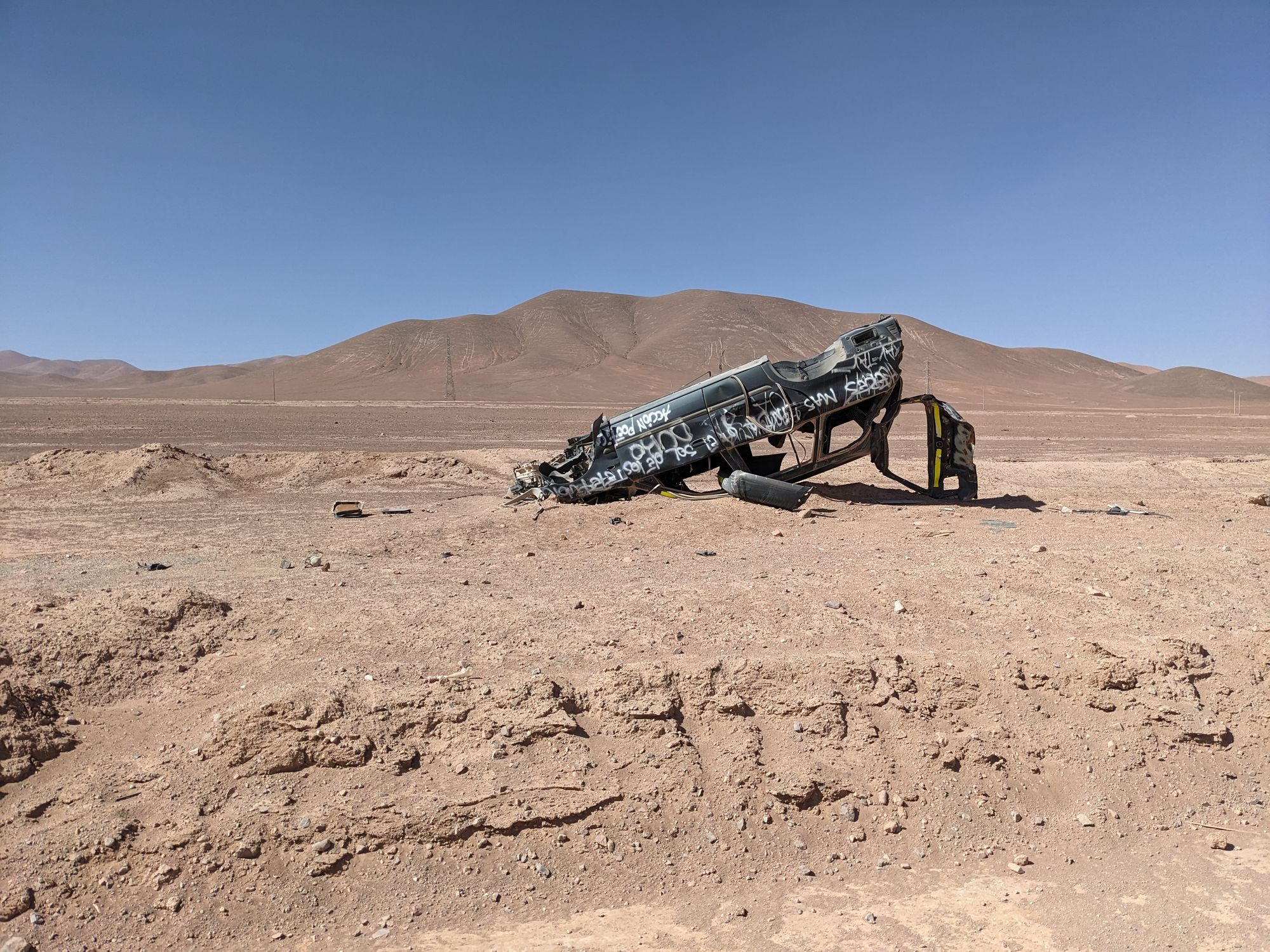
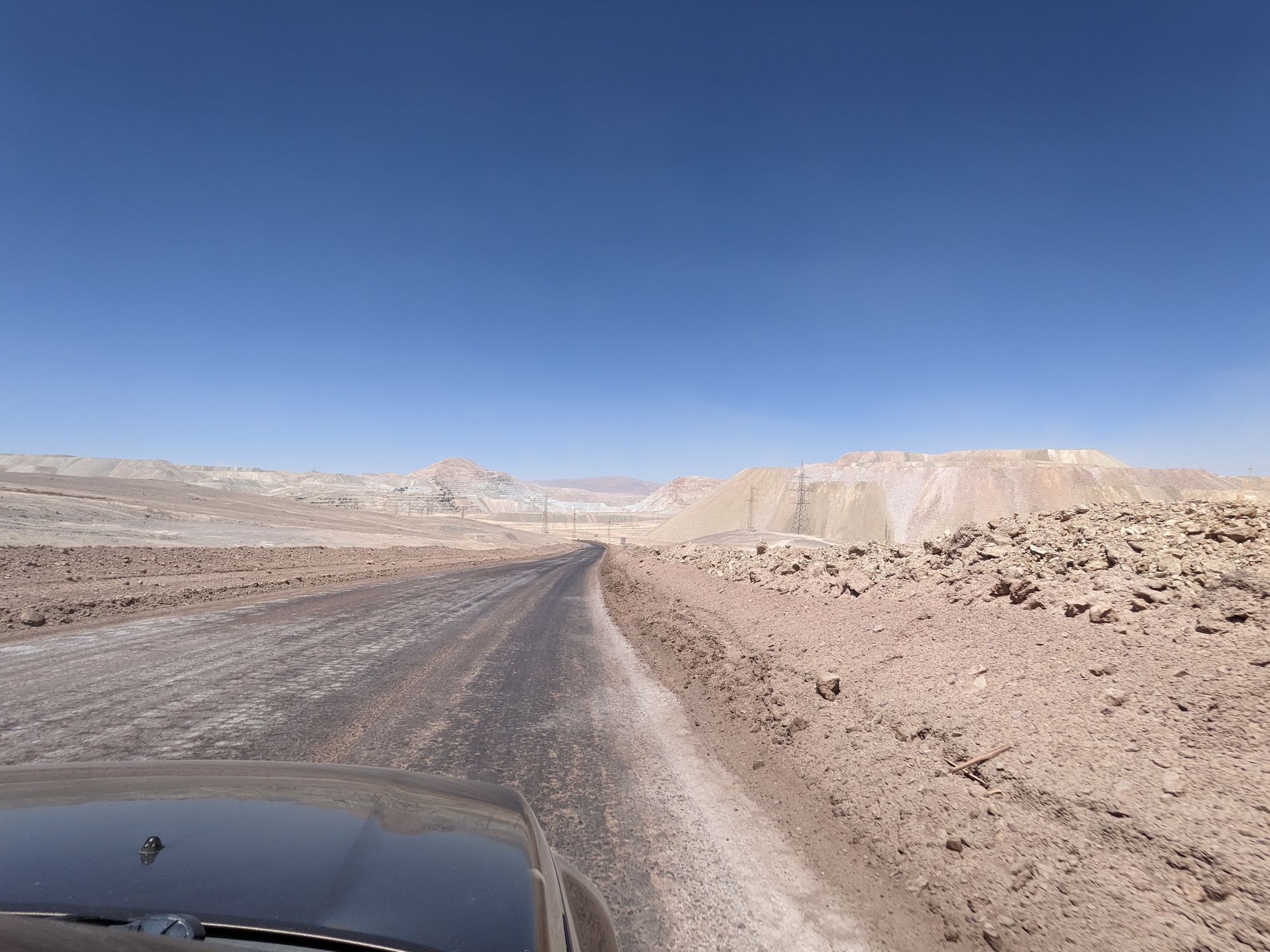

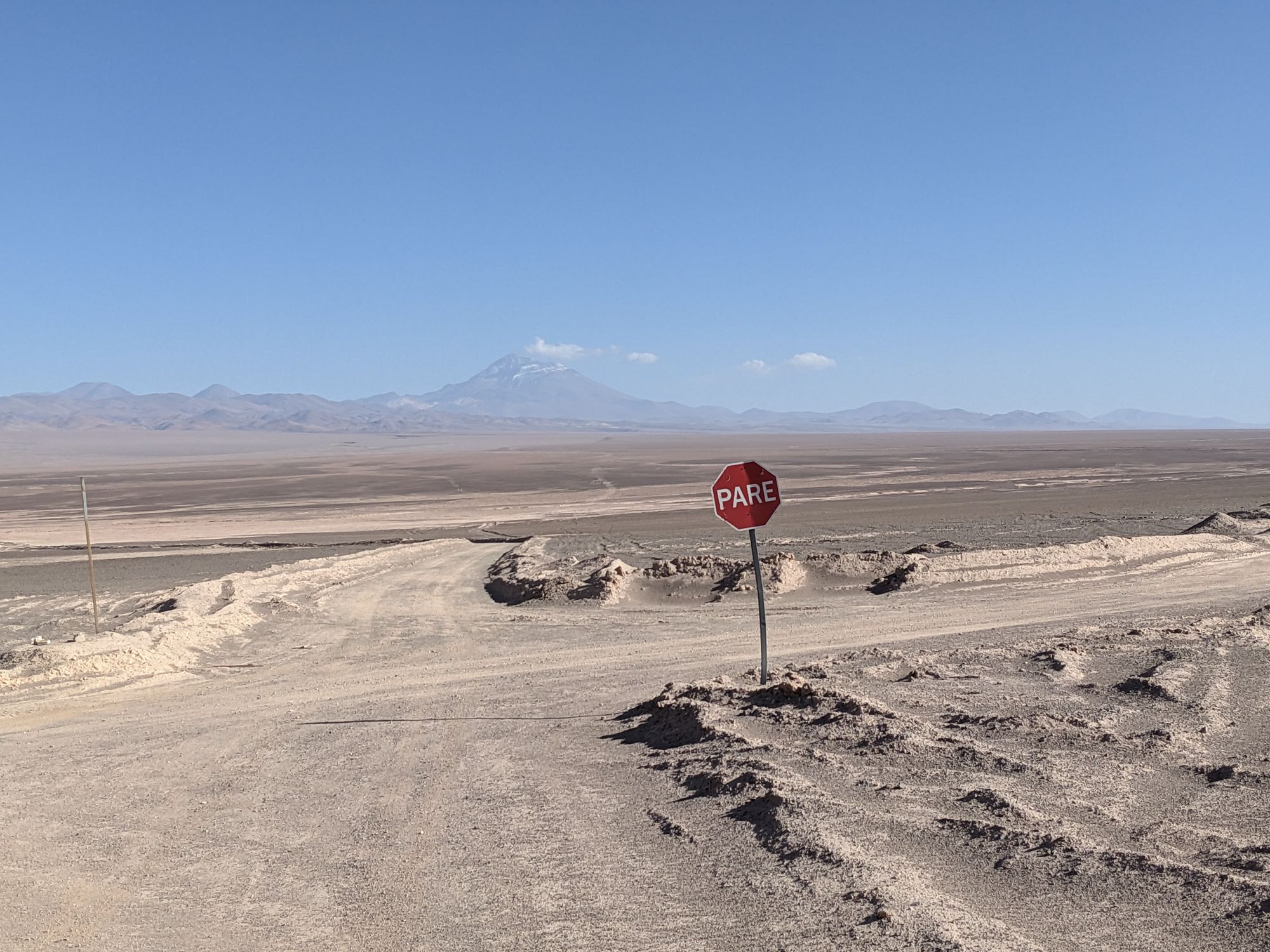
Dusk painted the sky as we reached our haven—Refugio Zorritas. Beyond being a mere shelter, Refugio Zorritas encapsulates the very essence of mountaineering. These three shelters, a solitary presence in the vast wilderness, bear silent witness to countless stories of climbers—the highs, the lows, and the dreams. As we settled in, the ambiance was a mix of reflection, anticipation, and shared camaraderie.
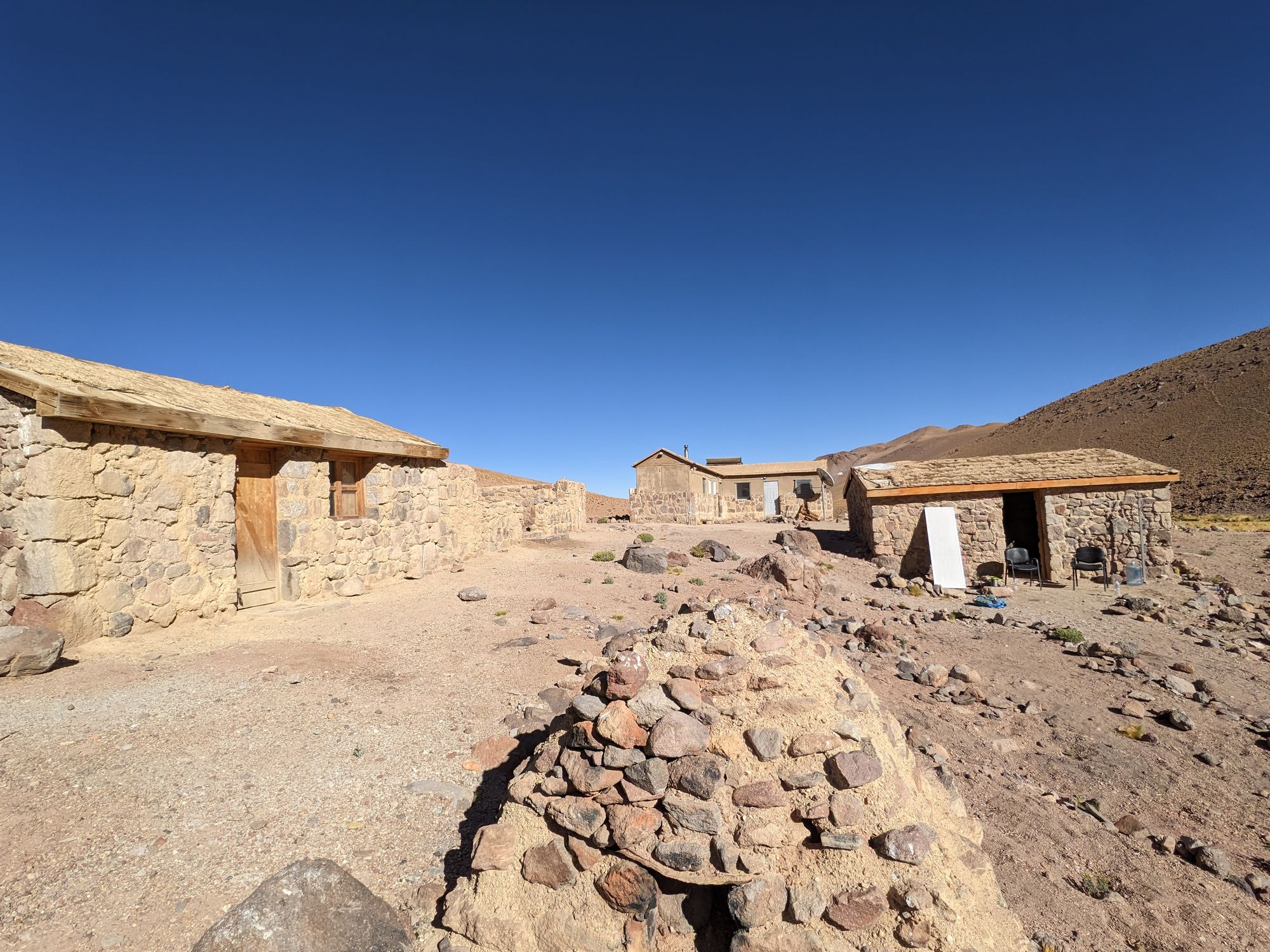
Climb to Camp 1 on LLullaillaco from the vehicle basecamp
The dawn heralded our next move—heading to Llullaillaco's vehicle basecamp. A cautionary note to future adventurers: this region bears scars from a tumultuous past, with dormant minefields still posing a threat.
Continuing our journey from the Vehicle Basecamp, perched at a significant elevation of 4,600 meters, our admiration for Llullaillaco deepened. Those acquainted with the mountaineering intricacies of the Andes know the value of hydration. Given the sparse water sources en route to Camp 2, we made sure our reserves were generously stocked.
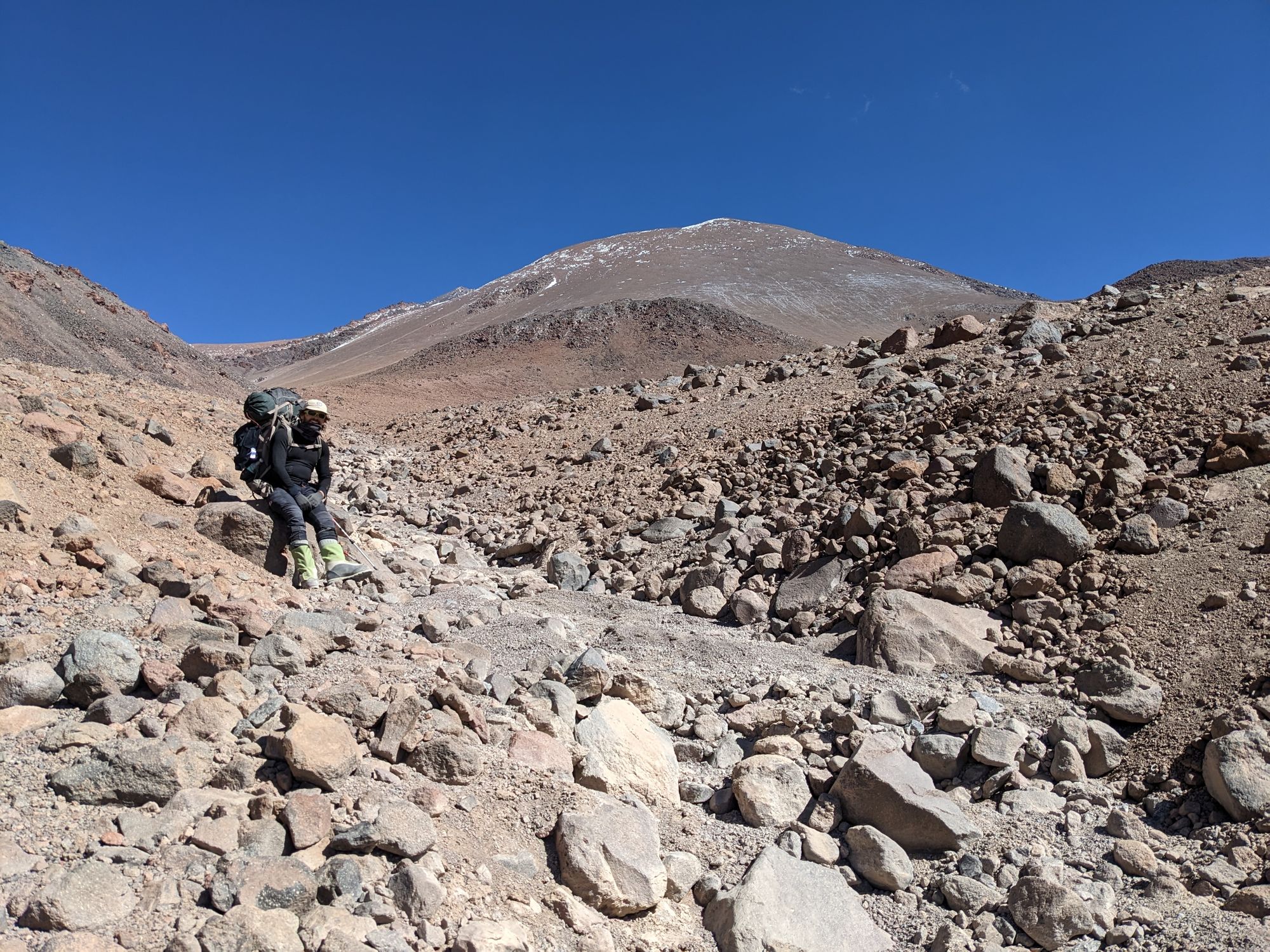
As we progressed, an unforeseen challenge arose. Barely an hour into our trek, my shoe's sole began to give way. This setback, although initially disheartening, was mitigated by our preparedness. We had a pair of spare shoes safely stored in Susi. The decision was made to backtrack, leaving our backpacks as markers of our brief progress.
The path was a mosaic of shifting terrains. The loose volcanic sand made each stride laborious, offering minimal traction. Stones and rubble occasionally interrupted our path, demanding careful footing. These natural obstacles, coupled with our heavy packs and the altitude's thin air, tested our stamina.
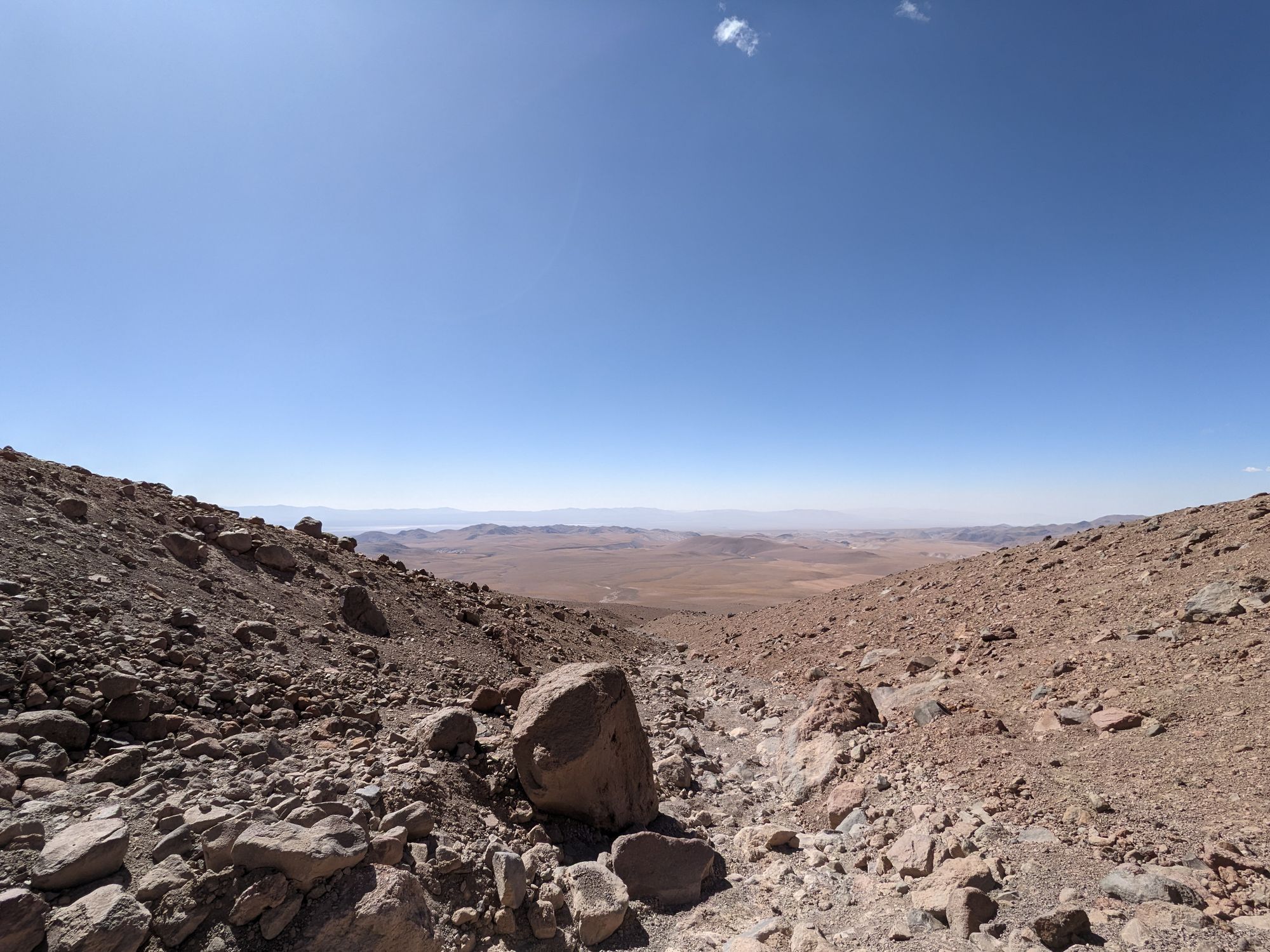
By the time we reached an altitude of around 5,100 meters, we collectively felt it was the ideal spot to camp for the night. As the sun set, casting the Andean peaks in a soft glow, the temperatures dropped. We set up our tents, seeking shelter from the approaching chill. For dinner, we indulged in a simple yet heartening meal of polenta, the warmth of which contrasted the cool evening air.
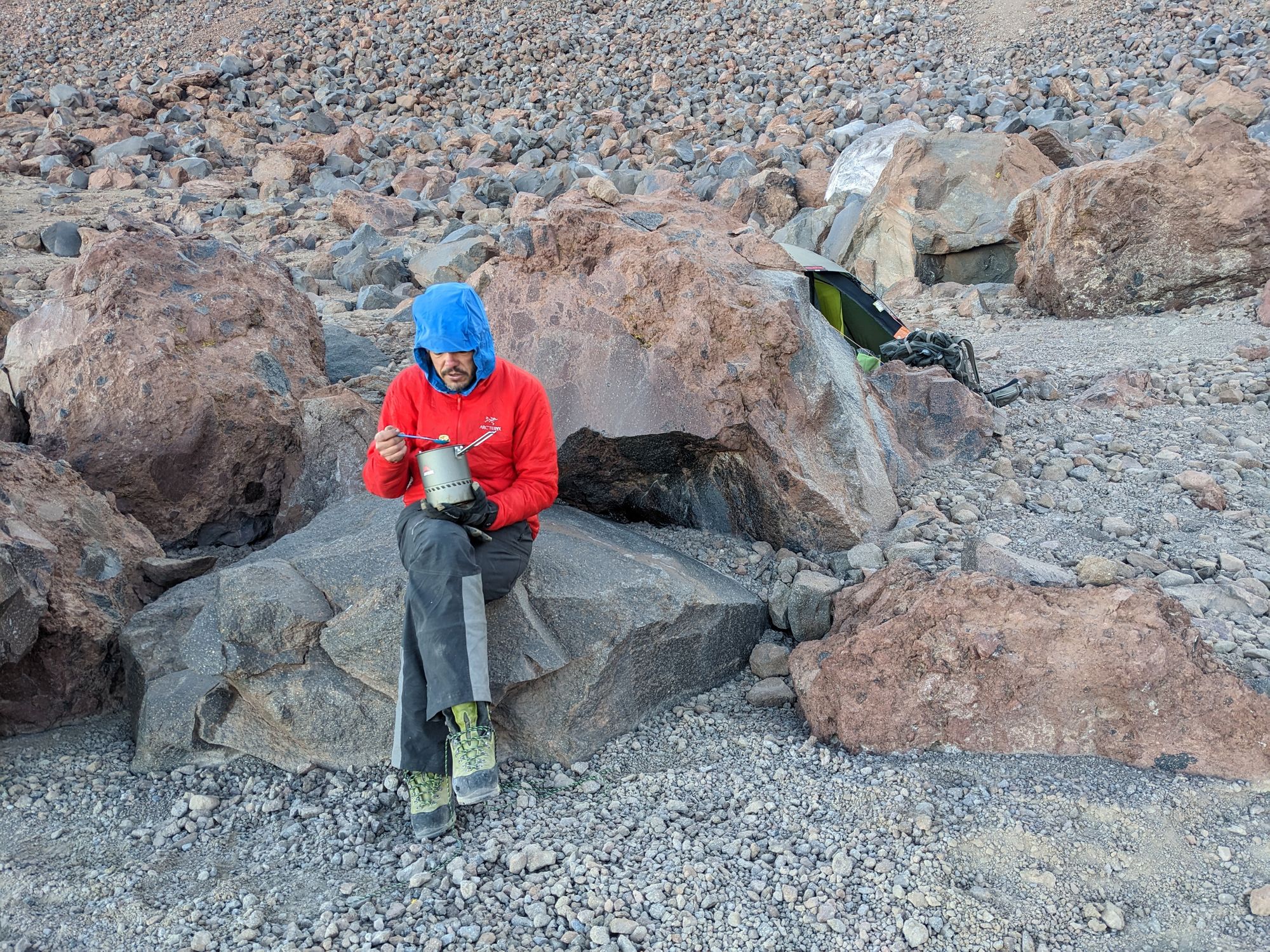
Camp 1 to Camp2 on Mount Llullaillaco
The brisk morning air made us draw our jackets tighter as we relished our muesli and the warmth of freshly brewed coffee. It wasn't long before the silence of our surroundings was interrupted by the approaching footsteps of a couple of Germans. Their gear and demeanor indicated they were on their descent from Llullaillaco.
Though our interaction was brief, it was filled with a quick exchange of insights. One of the Germans, with a straightforward demeanor, shared a crucial piece of advice for our ascent: "Keep with the stream-like valley as long as you can. Don't make the left turn too soon." The specificity of his tip caught my attention, but somehow, amidst our brief interaction, I misunderstood the exact nature of his recommendation.
The pair didn't linger for long. After a few nods and mutual wishes for safe journeys, they continued on their way, their figures soon merging with the mountainous backdrop.
With their advice in the back of my mind, albeit misinterpreted, we started our preparations for the day. Given the mention of snow at the subsequent camp, we opted to leave some water behind, eager to reduce our load.
Continuing our ascent to Camp 2, the terrain grew even more challenging. With every step, our boots crunched through the volcanic sand, interspersed with relentless rubble, boulders, and stones. Each stride became a tale of endurance, made even more arduous by the mountain's altitude. But there was a silver lining. Our packs felt lighter, thanks to our decision to leave behind some water, anticipating snow at the next camp.

The hours seemed to meld into one another, but after what felt like an eternity, approximately 4-5 hours, we arrived at Camp 2, perched at an elevation of 5,800 meters. Though our spirits were high, the early signs of altitude sickness began to manifest. A throbbing headache was a stark reminder that our acclimatization was not yet complete.

As we scouted the area for an ideal spot to pitch our tent, a small ledge caught our eye. This vantage point offered breathtaking views of the Chilean Atacama, a landscape steeped in beauty and desolation. However, the spot proved slightly challenging for my Hilleberg Staika tent. The confined space meant that securing the tent required extra precision.
By the time the tent was up, exhaustion weighed heavily on us. The thin air seemed to squeeze our appetite away. Despite our best efforts, the food remained untouched—our stomachs rebelling against the altitude's effects.
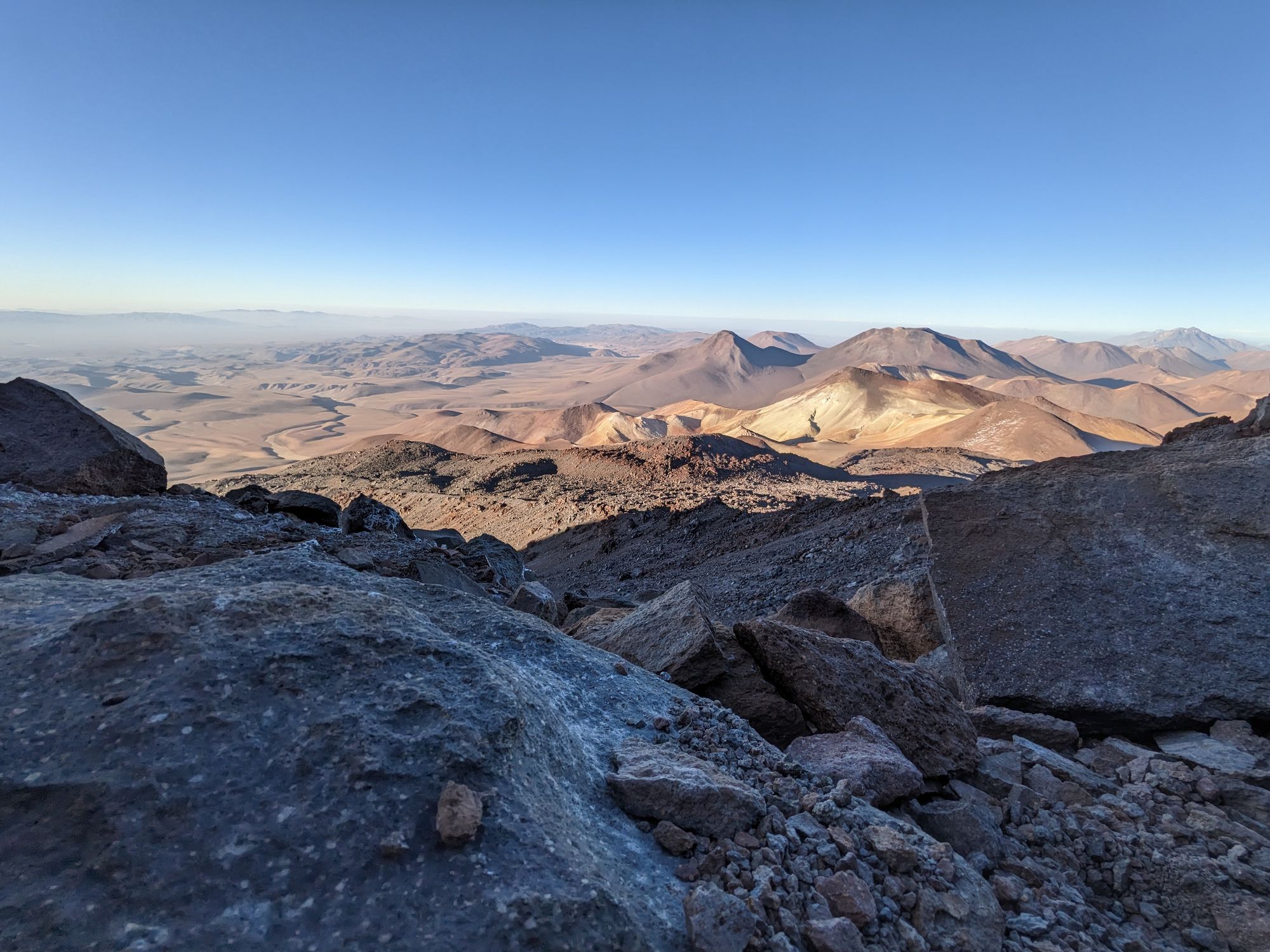
As darkness embraced the camp, I nestled into my sleeping bag, hoping for a restful night. However, the night was anything but peaceful. The constant waking made the hours stretch out interminably, and before I knew it, the shrill ring of the alarm at 4:30 am signaled a new day.
The day of climbing the vulcano Llullaillaco
Getting up was a battle in itself. Each movement was painstakingly slow. The fatigue, combined with the altitude, made every task feel like an arduous chore. After what felt like an unusually long preparation time, we were finally ready to resume our ascent by 5:30 am.
No sooner had we left Camp 2 than we encountered our first patch of ice and snow. Without hesitation, we strapped on our crampons, the spikes biting into the frozen ground, giving us much-needed traction. The cold was biting, and with every few steps, I paused to take deep breaths, filling my lungs with the thin mountain air.
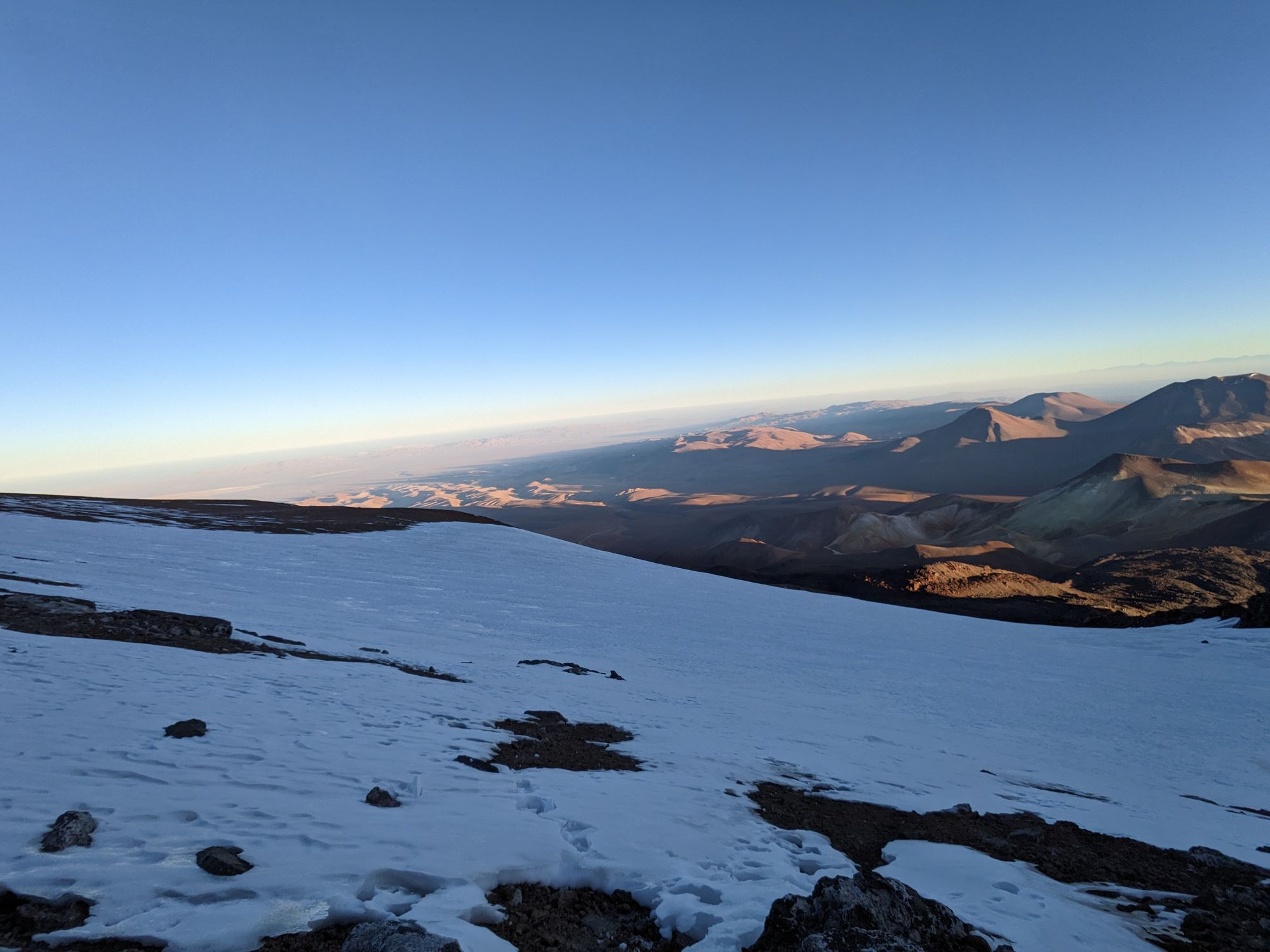
However, about an hour into our climb, my partner's pace began to slow. He looked pallid, his energy sapped. Concerned, I watched as he took a moment to gather himself, only to relay the heart-wrenching news—he felt too ill to continue. After a brief discussion, he made the difficult decision to descend. I watched him for a moment, torn between concern for my friend and the pull of Llullaillaco's summit. But with a heavy heart and a resolute spirit, I pressed on, facing the peak's challenges alone.
As my partner's figure retreated into the distance, a profound solitude descended upon me. Now alone, I faced the remainder of what was once a grand glacier—still challenging, though perhaps less imposing than its full, ancient expanse. Each step in the compacted snow was a negotiation between my crampons and the surface beneath, a dance that became progressively more demanding with the increasing altitude.
Drawing each breath felt like coaxing air through a fine sieve; the oxygen level seemed to wane with every meter ascended. Time elongated, stretching each minute into what felt like hours. Eventually, the residual glacier gave way to a slope covered in a mix of stones and volcanic sand. The ascent was grueling, as for every two steps I took upwards, the loose terrain pulled me one step back. This part of the mountain seemed to challenge not just my physical stamina but also my mental resolve.
It was upon reaching the ridge that an unsettling realization dawned on me: I had been following the wrong path ever since my partner had turned back. A rush of frustration enveloped me, fueled by the memory of the German mountaineer's advice. It wasn't that his guidance had been incorrect; rather, my interpretation of it had led me astray. There I stood, not before Llullaillaco's grand summit, but its secondary, less-celebrated peak.
My options unfurled before me like a branching mountain trail. First, I could admit defeat and turn back, respecting the mountain's taciturn admonition. Second, I could retrace my steps, hoping to find the correct path but at the cost of invaluable time. Or third, I could venture across this unplanned peak, gambling that it might connect me to the path leading to Llullaillaco's true summit.
After a moment of inner debate, I chose the third option. A combination of stubborn resolve, the allure of adventure, and the day's agreeable weather nudged me forward. With a mix of resignation and renewed determination, I hoisted my backpack and set off towards this inadvertent destination. Each step became a question, a pondering of what lay on the other side—would it be a correction of my navigational misstep, or a further divergence from my ultimate goal?
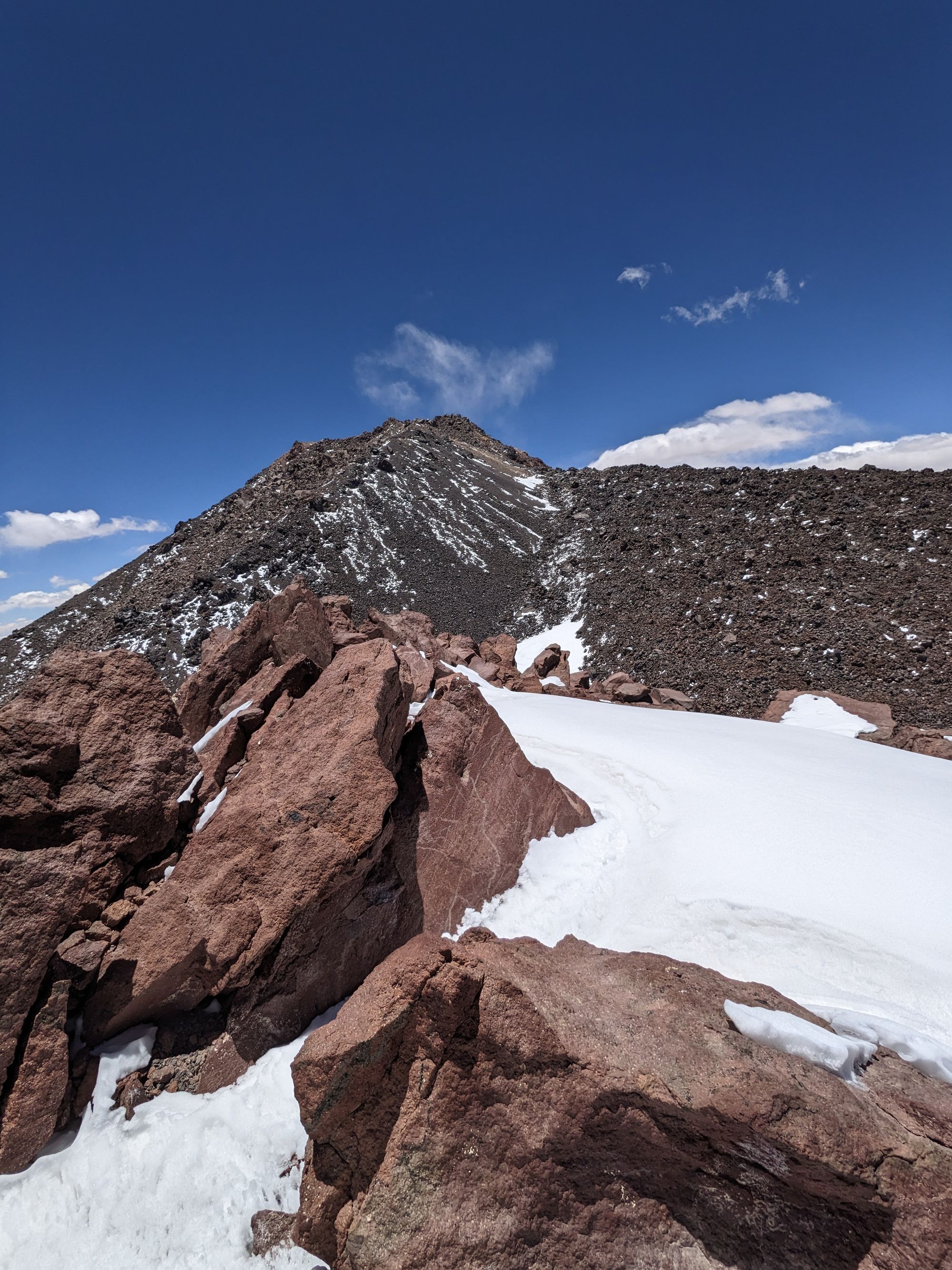
In a journey replete with formidable terrain, internal and external challenges, and the capricious elements of high-altitude mountaineering, Llullaillaco offered one final lesson. Sometimes the path to your aspirations is not straightforward; it can be a convoluted series of trials and errors, each serving as a lesson steering you towards—or away from—the summit of your dreams.
After what felt like an endless uphill battle, I reached the false summit at approximately 6,600 meters above sea level. Though the main summit of Llullaillaco tantalizingly appeared within reach, I knew better. Despite the visual closeness, the true summit was still a considerable distance away.
Taking a short breather, I scanned the horizon for a potential route that would lead me down and onto the correct trail to Llullaillaco's primary peak. At first, my options appeared grim; the mountain seemed unyielding in its obstructions. Finally, my eyes caught sight of a steep, snow-covered chute—risky but the quickest way down. Digging my heels into the soft snow, I made a rapid descent, utilizing the natural slide as a makeshift shortcut. After half an hour, the slope evened out, and the snow melted into a rocky path: I was back on track.
Time was a relentless force, reminding me that daylight was dwindling. Glancing at my watch, it struck me that it was already 3 p.m. I paused to ponder my options, fully aware of the gravity of the decision that loomed. Exhaustion clung to me like a second layer of clothing; every muscle, every tendon urged me to retreat. Yet, the summit was only 200 meters away—deceptively close but demanding an exhaustive climb.

After 15 minutes of wavering, I chose—perhaps unwisely—to proceed. Step by arduous step, I advanced. Each footfall was a monumental effort, each meter gained a testament to sheer will. The trek was a blend of stumbling over large boulders, navigating through a sea of crumbling rubble, and slipping on shifting volcanic sand. As I reached the base of the final ascent, pausing for one last brief respite, I couldn't help but think how far I'd come.
Glimpsing at my GPS, the reading showed that a mere 25 meters of altitude separated me from the summit. This revelation provided a much-needed boost to my flagging spirits. New energy coursed through me, and I was reinvigorated for the final push.
Heaving myself over massive rocks and navigating through a labyrinth of boulders, every step demanded an immense exertion of willpower. But I trudged on, drawing strength from the knowledge that I was tantalizingly close to the summit. And then, at approximately 7 p.m., I arrived. The summit of Mount Llullaillaco.
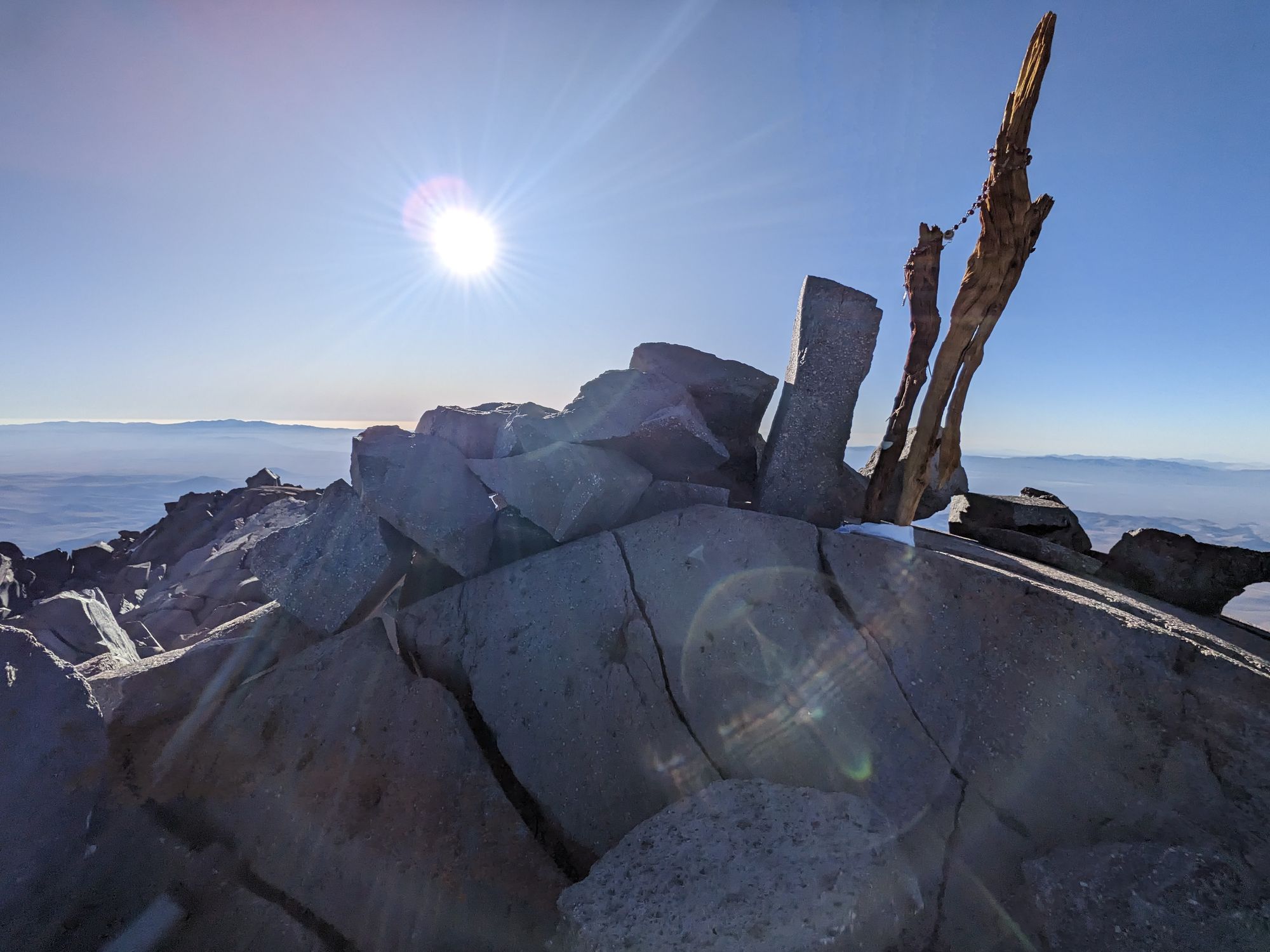
The feeling was a strange mix of elation and trepidation. My heart sang with the triumph of the ascent, yet a part of me was acutely aware of the descending sun. With only three or four hours left before the shroud of night would make the landscape pitch-black, time was of the essence. Thankfully, I had packed a headlamp, offering some reassurance against the impending darkness.
I took a brief moment to soak in the vista that surrounded me—the sweeping panorama of the Chilean Atacama stretched out like an infinite canvas. At that moment, the solitude of the peak weighed heavily, yet it was a loneliness that made me feel incredibly alive and strong.
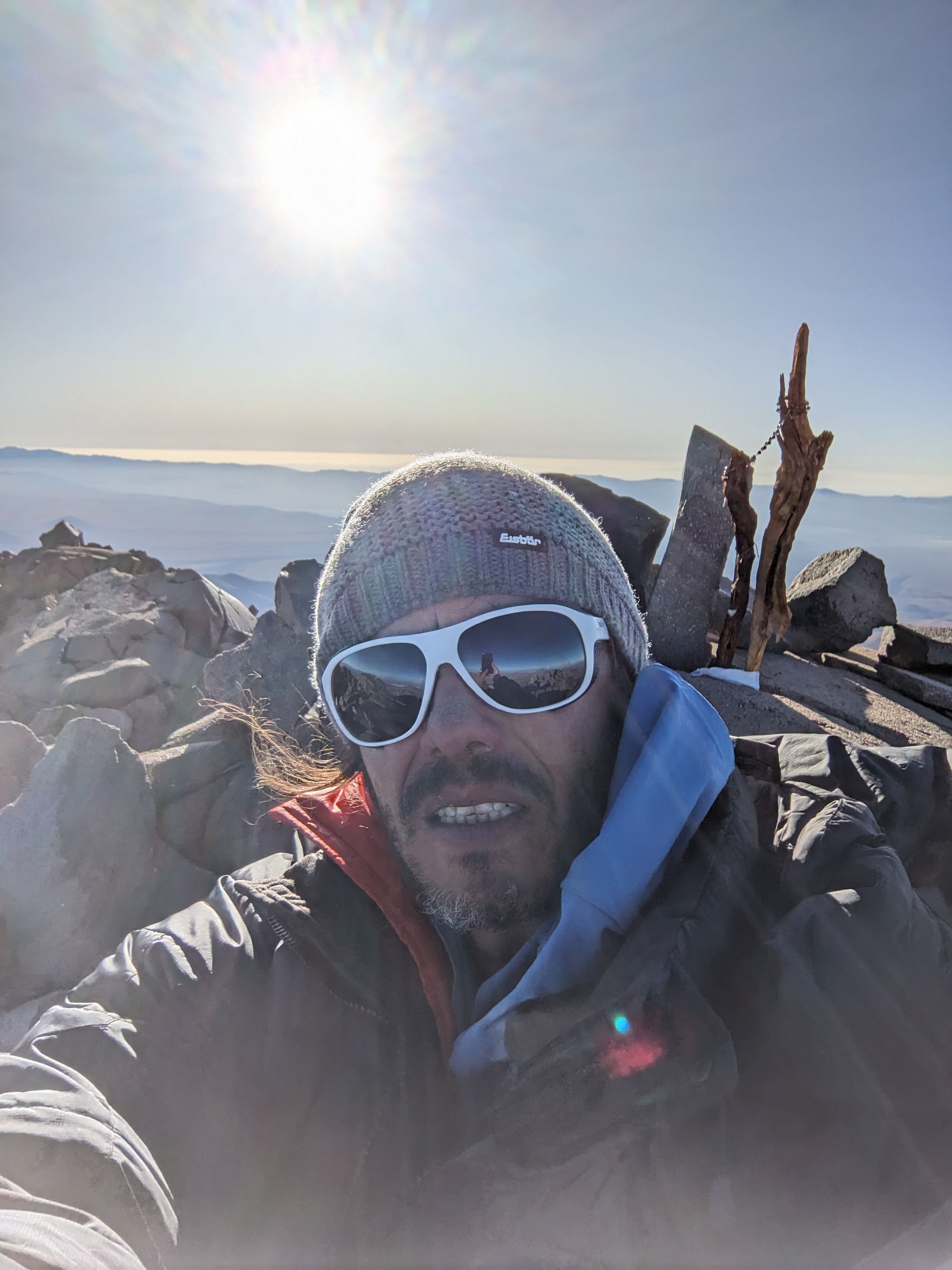
I snapped a few quick photos to immortalize the moment, took a last appreciative look at the scenery that had tested my limits in every conceivable way, and then began the precarious descent. Knowing full well the challenges that lay ahead, I fortified my resolve. There was no room for error, especially with the setting sun serving as a constant reminder that in the game between man and mountain, nature always holds the trump cards.
The hard descent to camp 2
Negotiating my way through the boulders on the descent, I moved at an accelerated pace, a combination of elation and urgency fueling me. "Two hours, maybe even less, and I'll be back at Camp 2," I thought, letting a wave of premature relief wash over me.
The next section of the terrain, consisting mainly of rubble, was manageable, though each step felt increasingly taxing. Fatigue was clawing its way in, but I pushed forward. And then I arrived at the stretch dotted with rocks and small boulders, each requiring a leap to progress.
In a less depleted state, I would've darted across these with relative ease. But fatigue makes even the experienced careless. Fueled by an adrenaline-charged combination of exhaustion and urgency, I misjudged a leap. My foot slipped and jammed between two rocks. A sharp pain surged through my leg, but a quick self-assessment confirmed no broken bones—only a jarring reminder of the ever-present dangers.
Frustration boiled over. I vented a string of expletives into the wind, half-expecting the mountain to share my annoyance. Shaking it off, I took a deep breath and recalibrated my approach. "Forget the encroaching dark," I thought, "You have a lamp. But more importantly, you're entirely alone. Caution is not optional; it's imperative."
Reaffirming my commitment to safety over speed, I meticulously began my descent anew, this time with the care and deliberation that the mountain—especially when solo trekking—rightfully demands.
As the clock ticked past 8 PM, I recalibrated my focus and began navigating the labyrinthine boulders and rocks that framed the valley's end, where the remnants of the glacier awaited. My progress, while slow and deliberate, was unwavering. By 10 PM, I reached the snowy threshold, and the sun was now a mere whisper of light, casting long shadows that danced with the emerging night.
Stepping onto the remnants of the glacier, each step became a Herculean task. The snow seemed to pull me deeper with every move, as if the Earth itself was trying to swallow me whole. The exhaustion was no longer just a sensation; it was a physical weight, each muscle aching in vocal protest. Brief pauses became frequent, not only to catch my breath but to brace myself for the next grueling step.
Eventually, the last rays of the sun surrendered to the night, enveloping me in pitch-black darkness. Thankfully, my lamp provided the minimal guidance needed to continue this harrowing descent. Breaks became more frequent, yet the resolve to reach the camp remained steadfast.
It was 11:30 PM when the dim silhouette of the tent materialized before me, a sight for sore eyes—or perhaps a mirage conjured by a tired mind. But as I approached, my climbing partner emerged, his face awash with relief and concern. We had been cut off from each other, miles apart, yet in that moment, the relief was mutual. We hugged, a wordless exchange that communicated more than any speech could.
As I sank into my sleeping bag, the coziness felt like a luxury undeserved, but highly appreciated. Though I was mentally and physically drained, I shared a truncated version of the day's events with my partner over a humble meal. With the last bites and sips, exhaustion finally claimed me, pulling me into a sleep so deep it was almost an extension of the mountain's embrace
Back to Antofagasta
The next day greeted us with the promise of descent, a far less daunting prospect than the climb. We packed up our gear, each fold and roll of the tent a symbolic end to this chapter of our adventure. The descent was straightforward, and soon enough, we found ourselves back at our trusted Jeep, Susi, who waited patiently to ferry us back to civilization.
The drive to Antofagasta was tinged with a mixture of exhaustion and accomplishment, punctuated by the growling reminder of our empty stomachs. Our hunger was not just for food, but for normalcy, for a moment of pause after the relentless challenge of the mountains.
And so, we found ourselves in a bustling Mexican restaurant in the heart of the city. As we sat down to a hearty meal, the flavors seemed to explode with a vibrancy that only intense physical exertion could enhance. It was a simple pleasure, but in that moment, it felt like the grandest of feasts.
As we raised our glasses for a toast, I reflected on the journey—its highs and lows, its trials and triumphs. While the mountain may have tested us, it also taught us—about our limits, our strengths, and the beauty of the natural world. I looked forward to the adventures that awaited, but for now, this meal, this moment of rest, was adventure enough.
And so we ate, our appetites for both food and life fully satiated, each bite a celebration not just of the meal before us, but of the incredible journey that brought us here. Cheers to that.

